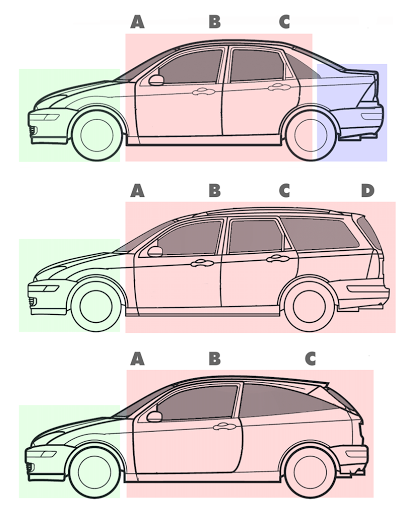A sedan , or saloon, is a passenger car in a three-box configuration with separate compartments for engine, passenger, and cargo.
Sedan's first recorded use as a name for a car body was in 1912. The name comes from a 17th-century development of a litter, the sedan chair, a one-person enclosed box with windows and carried by porters.
Variations of the sedan style of body include: close-coupled sedan, club sedan, convertible sedan, fastback sedan, hardtop sedan, notchback sedan and sedanet/sedanette.
Definition
The current definition of a sedan is a car with a closed body (i.e. a fixed metal roof) with the engine, passengers, and cargo in separate compartments. This broad definition does not differentiate sedans from various other car body styles, but in practice the typical characteristics of sedans are:
-
a B-pillar (between the front and rear windows) that supports the roof
-
two rows of seats(p134)
-
a three-box design with the engine at the front and the cargo area at the rear
-
a less steeply sloping roofline than a coupé, which results in increased headroom for rear passenger and a less sporting appearance.
-
a rear interior volume of at least 33 cu ft (0.93 m3)
It is sometimes suggested that sedans must have four doors (to provide a simple distinction between sedans and two-door coupés). However, several sources state that a sedan can have two or four doors.(p134) In addition, terms such as sedan and coupé have been more loosely interpreted by car manufacturers since 2010.
When a manufacturer produces two-door sedan and four-door sedan versions of the same model, the shape and position of the greenhouse on both versions may be identical, with only the B-pillar positioned further back to accommodate the longer doors on the two-door versions.[
In American English and Latin American Spanish, the term sedan is used (accented as sedán in Spanish).
In British English, a car of this configuration is called a saloon. Hatchback sedans are known simply as hatchbacks (not hatchback saloons); long-wheelbase luxury saloons with a division between the driver and passengers are limousines. An equivalent term for Sports sedan in the United Kingdom is "super saloon".
In Australia and New Zealand sedan is now predominantly used, they were previously simply cars. In the 21st century saloon is still found in the long-established names of particular motor races.[citation needed]
In other languages, sedans are known as berline (French), berlina (European Spanish, European Portuguese, Romanian, and Italian) though they may include hatchbacks. These names, like sedan, all come from forms of passenger transport used before the advent of automobiles. In German, a sedan is called Limousine and a limousine is a Stretch-Limousine.
In the United States two-door sedan models were punningly called "Tudor"; by extension, Ford used "Fordor" for four-door sedans.
Standard Styles
In the United States notchback sedan distinguishes models with a horizontal trunklid. The term is generally only referred to in the marketing when it is necessary to distinguish between two sedan body styles (e.g. notchback and fastback) of the same model range.
 |
| Citroen C4 Sedan Notchback. Courtesy of motor1.com |
Several sedans have a fastback profile, but instead of a trunk lid, the entire back of the vehicle lifts up (using a liftgate or hatch). Examples include the Chevrolet Malibu Maxx, Audi A5 Sportback and Tesla Model S.
The names "hatchback" and "sedan" are often used to differentiate between body styles of the same model. Therefore the term "hatchback sedan" is not often used, to avoid confusion.
 |
| Chevrolet Malibu Liftback Sedan: Courtesy of www.burienchevrolet.com |
There have been many sedans with a fastback style. i.e. Volskwagen Beetle, Mercedes Benz CLS.
 |
| VW Beetle fastback sedan. Courtesy of driving.ca |
Hardtop Sedans
Hardtop sedans were a popular body style in the United States from the 1950s to the 1970s. Hardtops are manufactured without a B-pillar leaving uninterrupted open space or, when closed, glass along the side of the car. The top was intended to look like a convertible's top but it was fixed and made of hard material that did not fold.
All manufacturers in the United States from the early 1950s into the 1970s provided at least a 2-door hardtop model in their range and, if their engineers could manage it, a 4-door hardtop as well. The lack of side-bracing demanded a particularly strong and heavy chassis frame to combat unavoidable flexing. The pillar-less design was also available in four-door models using unibody construction. For example, Chrysler moved to unibody designs for most of its models in 1960 and American Motors offered four-door sedans, as well a four-door station wagon from 1958 to 1960 Ambassador.
 |
| 1957 Cadillac El Dorado Brougham 4. Courtesy of Wikipedia |
In 1973 the US government passed Federal Motor Vehicle Safety Standard 216 creating a standard roof strength test to measure the integrity of roof structure in motor vehicles to come into effect some years later. Production of hardtop sedan body style ended with the 1978 Chrysler Newport. For a time roofs were covered with vinyl and B-pillars were minimized by using styling tricks like matt black finishes. Stylists and engineers soon developed more subtle solutions.



